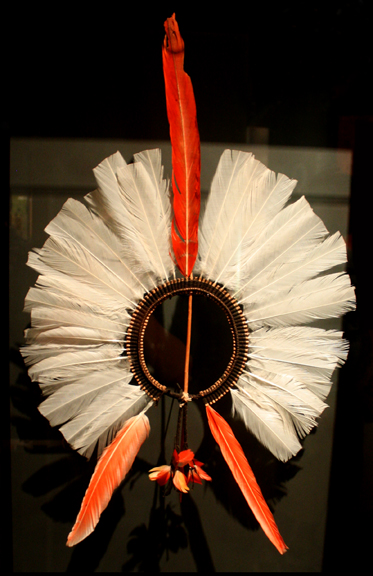
Kayapó headdress, C. 1910. Courtesy National Museum of the American Indian, Smithsonian Institution, Washington, DC. Image: Wikimedia Commons
Dec 23, 2011
In parts of the Amazonian rainforest, traditional costume included a headdress consisting of a circular arrangement of feathers. The ring of 36 feathers, most of which are white, lacks an obvious counterpart in the skies we see above us.
The above example was collected in c. 1910 from the Kayapó, a small nation living in central Brazil, and was locally known as an ȧkkȧpa-ri or a ‘footed feather headdress’.
In stark contrast to the modern world, traditional societies often used to derive their fashion standards from mythological or religious sources, looking backward rather than ahead for inspiration. Jolene Rickard and Gabrielle Tayac, of the Smithsonian Museum of the American Indian, explain that the ȧkkȧpa-ri ‘reflects the Kayapó view of the universe’. It is a cosmogram, representative of the sky, which is inserted in a beeswax hat known as a kutop, that signifies ‘the physical world’. The wooden stick running vertically through the opening is interpreted as ‘the rope that Kayapó descended to reach this earth’. In the latter, anthropologists readily recognise an expression of the axis mundi, a vertical connector between the spiritual realms above and the human world here below.
None of this would make any headlines were it not for the awkward fact that the ‘world’ or the ‘sky’ looks nothing like the Kayapó outfit. If the heavens are circular, no vertical ‘rope’ is seen to dangle down from the centre. Neither the central red feather on top nor the two orange feathers flanking the bottom strike one as familiar.
In the absence of any further clarification from Kayapó informants, a competition of scholars’ informed guesses is the best we can muster. Should the starburst pattern remind some of the rays of the sun, the sparse information culled from the Kayapó is already violated, for an image of the sun cannot at the same time represent the cosmos – whereas a conceptual link between the sun and an ancestral rope from heaven cannot be assumed without firmer evidence.
The earth is immersed in a sea of plasma, distributed across its ionosphere, its magnetosphere and the solar wind. While this may be over the heads of some people, an understanding of this plasma environment offers an unexpected and quite adventurous solution to the mystery of the Kayapó crown.
The familiar ‘curtains’ formed by the earth’s aurorae are the result of so-called diocotron instabilities, in which a hollow sheath of plasma breaks up into a cylindrical ring of discrete filaments. These typically number 112 or 56 at first and subsequently merge in pairs or groups of three as they revolve.
Plasma physicist Anthony Peratt proposed that one or more extreme solar storms transpiring in the early Holocene temporarily transformed the earth’s plasma environment into a single, collimated plasma tube – displaying a bewildering array of instabilities that included the diocotron type. Consequently, a structure very much like the Kayapó crown may have been visible in the sky at those times. Structural analogues to this formation can be found in medicine wheels and stone circles, maṇḍalas, Maypole-style dances, and various other aspects of traditional ‘sacred culture’.
A daring hypothesis it is, but could Peratt have been heading in the right direction? At the very least, an in-depth study of prehistoric fluctuations in the earth’s geomagnetic field would be a feather in the hat of any open-minded scientist.
Rens Van Der Sluijs
Books by Rens Van Der Sluijs:
Traditional Cosmology: The Global Mythology of Cosmic Creation and Destruction
Volume One: Preliminaries Formation
The Mythology of the World Axis
The World Axis as an Atmospheric Phenomenon












